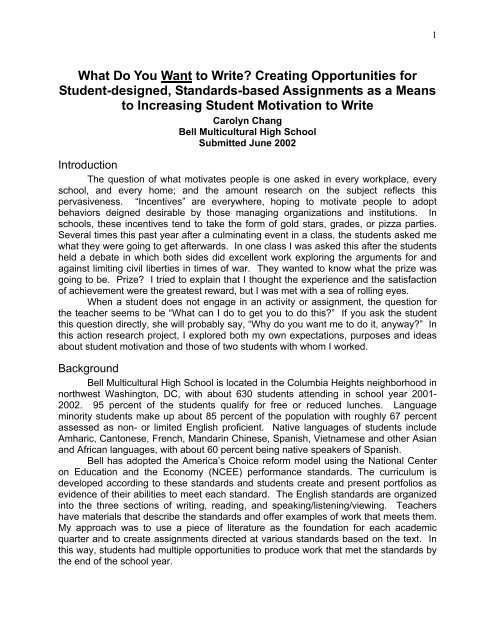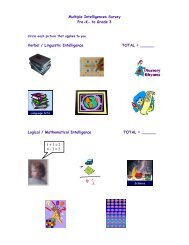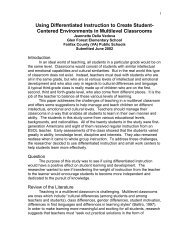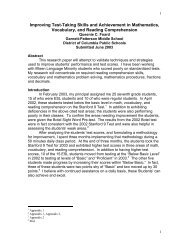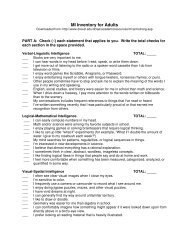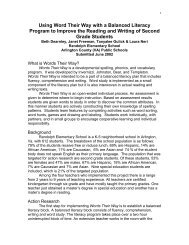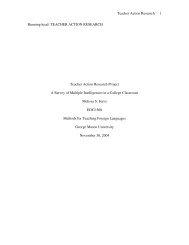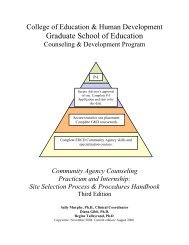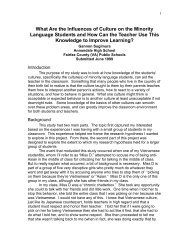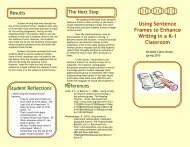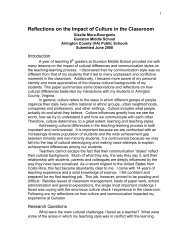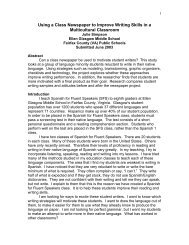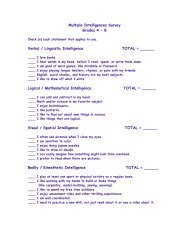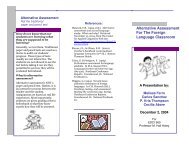What Do You Want to Write - GSE
What Do You Want to Write - GSE
What Do You Want to Write - GSE
Create successful ePaper yourself
Turn your PDF publications into a flip-book with our unique Google optimized e-Paper software.
1<br />
<strong>What</strong> <strong>Do</strong> <strong>You</strong> <strong>Want</strong> <strong>to</strong> <strong>Write</strong> Creating Opportunities for<br />
Student-designed, Standards-based Assignments as a Means<br />
<strong>to</strong> Increasing Student Motivation <strong>to</strong> <strong>Write</strong><br />
Carolyn Chang<br />
Bell Multicultural High School<br />
Submitted June 2002<br />
Introduction<br />
The question of what motivates people is one asked in every workplace, every<br />
school, and every home; and the amount research on the subject reflects this<br />
pervasiveness. “Incentives” are everywhere, hoping <strong>to</strong> motivate people <strong>to</strong> adopt<br />
behaviors deigned desirable by those managing organizations and institutions. In<br />
schools, these incentives tend <strong>to</strong> take the form of gold stars, grades, or pizza parties.<br />
Several times this past year after a culminating event in a class, the students asked me<br />
what they were going <strong>to</strong> get afterwards. In one class I was asked this after the students<br />
held a debate in which both sides did excellent work exploring the arguments for and<br />
against limiting civil liberties in times of war. They wanted <strong>to</strong> know what the prize was<br />
going <strong>to</strong> be. Prize I tried <strong>to</strong> explain that I thought the experience and the satisfaction<br />
of achievement were the greatest reward, but I was met with a sea of rolling eyes.<br />
When a student does not engage in an activity or assignment, the question for<br />
the teacher seems <strong>to</strong> be “<strong>What</strong> can I do <strong>to</strong> get you <strong>to</strong> do this” If you ask the student<br />
this question directly, she will probably say, “Why do you want me <strong>to</strong> do it, anyway” In<br />
this action research project, I explored both my own expectations, purposes and ideas<br />
about student motivation and those of two students with whom I worked.<br />
Background<br />
Bell Multicultural High School is located in the Columbia Heights neighborhood in<br />
northwest Washing<strong>to</strong>n, DC, with about 630 students attending in school year 2001-<br />
2002. 95 percent of the students qualify for free or reduced lunches. Language<br />
minority students make up about 85 percent of the population with roughly 67 percent<br />
assessed as non- or limited English proficient. Native languages of students include<br />
Amharic, Can<strong>to</strong>nese, French, Mandarin Chinese, Spanish, Vietnamese and other Asian<br />
and African languages, with about 60 percent being native speakers of Spanish.<br />
Bell has adopted the America’s Choice reform model using the National Center<br />
on Education and the Economy (NCEE) performance standards. The curriculum is<br />
developed according <strong>to</strong> these standards and students create and present portfolios as<br />
evidence of their abilities <strong>to</strong> meet each standard. The English standards are organized<br />
in<strong>to</strong> the three sections of writing, reading, and speaking/listening/viewing. Teachers<br />
have materials that describe the standards and offer examples of work that meets them.<br />
My approach was <strong>to</strong> use a piece of literature as the foundation for each academic<br />
quarter and <strong>to</strong> create assignments directed at various standards based on the text. In<br />
this way, students had multiple opportunities <strong>to</strong> produce work that met the standards by<br />
the end of the school year.
2<br />
The focus of this action research was an 11 th grade sheltered English III class for<br />
students who were assessed as LEP. Among the eleven students in the class, there<br />
was one native Mandarin Chinese speaker, two native Amharic speakers, and eight<br />
native Spanish speakers. I only began working with these students in the third quarter<br />
of the school year when another English teacher was out for health reasons. I worked<br />
with them alone until the middle of the fourth quarter, when the original teacher<br />
returned; at that point, we co-taught the class for the remainder of the school year.<br />
I had planned the third quarter 9-week plan around the reading of A Raisin in the<br />
Sun. In preparation for the reading of this play, students read a text about the features<br />
of drama and a short radio play in order <strong>to</strong> increase their understanding of the genre.<br />
They also read informational materials on segregation and the US Civil Rights<br />
Movement for his<strong>to</strong>rical context. While reading A Raisin in the Sun, we also watched<br />
the movie version, using a graphic organizer <strong>to</strong> help moni<strong>to</strong>r how the film differed from<br />
the play. In the end, the students were asked <strong>to</strong> write a response <strong>to</strong> literature essay<br />
comparing the two versions.<br />
The Question<br />
While most of the eleven students were engaged for the pre-reading and reading<br />
activities, two students, Javier and Arturo, were not doing the homework or any of the<br />
written work for the class. Their portfolios, homework, quiz/test grades, and classwork<br />
indicated <strong>to</strong> me high verbal skills and listening comprehension; but both were reluctant<br />
writers. In the case of Javier, he showed higher-order thinking skills in class<br />
discussions, and I was not sure if his reluctance <strong>to</strong> write was due <strong>to</strong> frustration with<br />
academic vocabulary or grammar limitations, or <strong>to</strong> a general rejection of schoolwork.<br />
He had had attendance problems since September and had apparently been in high<br />
school for several years. He liked <strong>to</strong> play the clown as well as the provocateur in class,<br />
and he had the sharp wit <strong>to</strong> play these parts well. At times he resented being asked <strong>to</strong><br />
participate in classroom activities, yet when he was interested in the <strong>to</strong>pic at hand he<br />
tended <strong>to</strong> monopolize conversations.<br />
Arturo, in contrast, seemed less confident in himself. His verbal skills were<br />
definitely stronger than his writing skills and his reading comprehension. When the<br />
class read scenes aloud, Walter was able <strong>to</strong> engage in interpretive and analytical<br />
discussions of the text, but his independent reading skills seemed weak. A couple of<br />
times Arturo tried <strong>to</strong> follow Javier’s lead in rebellion, but after each time, without fail, he<br />
would seek me out after school <strong>to</strong> express concern about passing the class and making<br />
up missed assignments. These conferences ended with his promises <strong>to</strong> do the<br />
assignments and <strong>to</strong> be more focused. In fact, he would eventually do most of the<br />
homework assignments, but he always did them late and never without reminders.<br />
Finally, while Javier was able <strong>to</strong> score among the <strong>to</strong>p of the class on tests without<br />
having done any of the homework assignments, Arturo struggled <strong>to</strong> pass even when he<br />
had participated in class activities and done the homework.<br />
During the reading of the short radio play at the beginning of the unit, both<br />
students were eager <strong>to</strong> participate when we read the play aloud in class; they were<br />
equally engaged in classroom discussions based on the his<strong>to</strong>rical background readings.<br />
As we began <strong>to</strong> read A Raisin in the Sun they appeared engaged by the s<strong>to</strong>ry, again<br />
eager <strong>to</strong> read scenes aloud and <strong>to</strong> discuss the action and themes, but they did little or
3<br />
none of the homework assignments such as answering comprehension questions or<br />
writing in response journals. As we started the pre-writing stage of the writing process<br />
for the response <strong>to</strong> literature essay, I wondered what I might do <strong>to</strong> encourage them <strong>to</strong><br />
do the assignment.<br />
Literature Review<br />
Motivation theory is generally delineated according <strong>to</strong> behaviorist and cognitive<br />
definitions, the former most commonly associated with the work of B. F. Skinner. A<br />
behaviorist definition of motivation rests on the idea that people will “pursue a goal<br />
because they perceive a reward for doing so,” thus defining motivation as “the<br />
anticipation of reinforcement” of certain behaviors (Brown, 1994, p.34-35). Applied <strong>to</strong><br />
learning situations, this theory contends that students will work <strong>to</strong> achieve certain goals<br />
in anticipation of external, or extrinsic, rewards. Imagine an English Language Learner<br />
whose homework is often undone or incomplete; according <strong>to</strong> behaviorist theories,<br />
punishing this behavior with something like after-school detention will eventually<br />
encourage the student <strong>to</strong> do her homework. Underlying this definition of motivation is<br />
the concept that “response = learning,” that is, exhibiting a particular behavior<br />
demonstrates knowledge or achievement (Pinar, 1996). Behaviorists thus came <strong>to</strong><br />
believe that human nature could be changed through the use of stimuli. This theory is<br />
evident in practices throughout our education system and in the workplace, from gold<br />
stars for perfect scores <strong>to</strong> bonuses for surpassing sales quotas (Kohn, 1993).<br />
In contrast, cognitive definitions of motivation emphasize its sources and the<br />
concept of self-reward. One cognitive-based theory of motivation is Maslow’s Hierarchy<br />
of Needs theory, which frames an understanding of human behavior along a continuum<br />
of needs that drive human behavior. The first set of needs consists of those for basic<br />
survival: air, water, food, sleep and exercise. Maslow maintained that once those basic<br />
needs are met, an individual is then motivated <strong>to</strong> pursue the next level of needs in the<br />
hierarchy. The hierarchy builds on the basic physical needs <strong>to</strong>wards goals of safety,<br />
emotional wellbeing, esteem, and finally self-actualization (see figure 1.1). Without<br />
meeting the preceding set of needs, an individual will not be motivated <strong>to</strong> pursue the<br />
needs of a higher level (Brown, 1994). Let’s return <strong>to</strong> the hypothetical English<br />
Language Learner who never does her homework, only now we find out that the<br />
homework is not complete because she must work every day after school and on the<br />
weekends <strong>to</strong> help support her family. Her exhaustion means she will have trouble<br />
pursuing goals of academic achievement, and keeping her after school may only serve<br />
<strong>to</strong> further alienate her from school since it will prevent her from going <strong>to</strong> work.
4<br />
Figure 1.1<br />
Maslow’s Hierarchy of Needs (Maslow, 1970)<br />
Selfactualization<br />
Esteem:<br />
Strength<br />
Esteem:<br />
Status<br />
Love<br />
Belongingness<br />
Affection<br />
Safety Security Protection<br />
Freedom<br />
from fear<br />
Air Water Food Rest Exercise<br />
Behavior is also often discussed in terms of whether it is intrinsically or<br />
extrinsically motivated. Deci (1975) defined intrinsically motivated activities as those<br />
“for which there is no apparent reward except the activity itself. People seem <strong>to</strong> engage<br />
in the activities for their own sake and not because they lead <strong>to</strong> an extrinsic reward.” As<br />
stated above, behaviorist definitions tend <strong>to</strong> be linked <strong>to</strong> extrinsic motivation, cognitive<br />
definitions with intrinsic motivation. Research has shown that intrinsically motivated<br />
activities more often lead <strong>to</strong> achievement of goals (Kohn, 1993; Brown, 1994), which<br />
has led some educa<strong>to</strong>rs <strong>to</strong> advocate for activities that “capitalize on the intrinsic by<br />
appealing <strong>to</strong> learners’ self-determination and au<strong>to</strong>nomy” (Brown, p.42). This<br />
encouragement of the intrinsic is coupled with criticism of extrinsic motiva<strong>to</strong>rs as<br />
creating a dependency that “focuses students <strong>to</strong>o exclusively on the material or<br />
monetary rewards of an education” and teaches them <strong>to</strong> “fear failure… and refrain from<br />
potentially rewarding risk-taking or innovative behavior” (Brown, p.40). However, Deci’s<br />
definition does not take in<strong>to</strong> account the rewards of meeting our needs at all levels of<br />
Maslow’s hierarchy. It seems more useful <strong>to</strong> consider motivation not in terms of<br />
whether or not there is a reward beyond the activity itself, but instead according <strong>to</strong><br />
whether the activity in question meets the needs of the student.
5<br />
In order <strong>to</strong> meet the needs of ELLs, thus tapping in<strong>to</strong> their intrinsic motivation,<br />
Brown (1994) suggests activities and techniques that engage student self-determination<br />
and au<strong>to</strong>nomy. For example, teaching writing as a means <strong>to</strong> develop ideas,<br />
demonstrating how prior knowledge enhances reading comprehension, and generally<br />
appealing <strong>to</strong> student interests, needs and purposes. Offering students choices about<br />
activities or <strong>to</strong>pics is also intrinsically motivating because they are more in control of<br />
their learning and can act on their needs as they see them instead of how the teacher<br />
perceives them (ibid.).<br />
The Project<br />
To address the question of how <strong>to</strong> encourage Arturo and Javier <strong>to</strong> write using the<br />
theories of intrinsic motivation and Maslow’s hierarchy as a framework, I decided <strong>to</strong><br />
open up the assignment <strong>to</strong> them by offering the possibility of designing it themselves.<br />
The performance standards for writing a response <strong>to</strong> literature would provide the<br />
guidelines in which they would be free <strong>to</strong> work. The thinking was that by turning over<br />
control of the assignment <strong>to</strong> them, they would be more deeply invested in producing<br />
written work and in theory would then be more intrinsically motivated <strong>to</strong> complete the<br />
assignment. The first step meant revisiting the standards for responses <strong>to</strong> literature and<br />
determining how <strong>to</strong> present them <strong>to</strong> the students as guidelines that would be clear and<br />
focused yet open <strong>to</strong> interpretation. The key feature of the standard seems <strong>to</strong> be that the<br />
student advances an interpretive, evaluative or analytic judgment and supports that<br />
judgment with references <strong>to</strong> the text. This judgment could involve a discussion of<br />
themes, a comparison of the text with its media version (the assignment the rest of the<br />
class was undertaking), or an analysis of the significance of the play.<br />
In class, I distributed the graphic organizers I had created <strong>to</strong> guide the students<br />
through the writing process for a five-paragraph essay comparing the play and the film.<br />
In presenting the assignment I reviewed the standards for response <strong>to</strong> literature and<br />
talked about how the essay would meet those standards. The class then began the<br />
pre-writing step of the process in pairs or groups of three. Javier and Arturo made no<br />
moves <strong>to</strong> work with each other or with their classmates, nor did they read the handouts<br />
in front of them. I talked with each of them individually <strong>to</strong> propose the alternative<br />
assignment, using a copy of the standards for response <strong>to</strong> literature as a reference. We<br />
talked about what each standard was saying in “plain English” and what examples of<br />
each might look like. I <strong>to</strong>ld them that what was most important was that they showed<br />
they could analyze the text and support their judgments with quotes from the play or, if<br />
they wanted <strong>to</strong> make a comparison, descriptions of scenes from the movie.<br />
Javier’s initial response was skepticism and he asked several questions <strong>to</strong> clarify<br />
what I was proposing. He wanted <strong>to</strong> know what the assignment was, what exactly were<br />
my expectations. I repeated that as long as he advanced a judgment and cited the text<br />
<strong>to</strong> support the judgment, the writing could take any form. He asked if that meant he<br />
could write a rap song, and again I <strong>to</strong>ld him that what was important was that he met the<br />
standards for response <strong>to</strong> literature. Javier appeared very excited at the prospect of a<br />
rap response. He began taking notes and trying out rhymes that discussed the<br />
significance of the scenes about Beneatha’s hair and the effect of not having those<br />
scenes in the movie. He worked on it for the rest of the class period.
6<br />
With Arturo, we spent more time talking about the standards and what they<br />
meant. He would appear <strong>to</strong> understand one aspect of the standards, but then reveal in<br />
a later comment that he had not unders<strong>to</strong>od it well. We ran out of time that first day<br />
before he could get started on the pre-writing step, and as he walked out of the room I<br />
was left with a strong sense that we would have <strong>to</strong> start all over again the next day,<br />
which proved correct.<br />
Arturo eventually came for extra help after school, telling me he didn’t want <strong>to</strong> fail<br />
and asking me <strong>to</strong> help him. At no point did he talk <strong>to</strong> me about responding <strong>to</strong> the play in<br />
some alternative form. He came with the handouts I had given <strong>to</strong> the class and <strong>to</strong>gether<br />
we went through each step. In the end, Arturo wrote an essay according <strong>to</strong> the<br />
guidelines I had initially given. Though he did make a judgment and include quotes<br />
from the text, the essay lacked explanations of how the references <strong>to</strong> the text supported<br />
the judgment. While he had been able <strong>to</strong> discuss these connections in conversation, he<br />
did not include them in his writing. When asked about it he claimed <strong>to</strong> have forgotten,<br />
but he did not take the opportunity <strong>to</strong> re-write the essay.<br />
Javier, who began the assignment with enthusiasm, did not come <strong>to</strong> school for<br />
nearly two weeks. When he finally returned, he said he had lost the work he had done<br />
on that first day. The end of the quarter was coming, but he said he no longer wanted<br />
<strong>to</strong> write the rap. We met at lunch <strong>to</strong> discuss what happened, why he was no longer<br />
motivated <strong>to</strong> write about what he clearly had strong ideas about, but he did not seem <strong>to</strong><br />
want <strong>to</strong> reflect on or share this with me. At one point he claimed it was because <strong>to</strong><br />
really express himself he would need <strong>to</strong> use foul language, and that since this was not<br />
allowed he had no interest in doing it at all. In fact, I had anticipated this and was<br />
prepared <strong>to</strong> suggest that he write two versions, one that was “his” and one that was<br />
school-appropriate, but I never had the opportunity <strong>to</strong> discuss this possibility with him.<br />
He also said that his language is a mixture of Spanish and English and that I would<br />
have insisted on English only, which we also never discussed. When asked why he<br />
would make those assumptions without trying <strong>to</strong> see what I really thought, he had no<br />
answer. Eventually, Javier s<strong>to</strong>pped coming <strong>to</strong> school.<br />
Findings, Implications and Further Questions<br />
While on the surface the experiment of offering students the opportunity <strong>to</strong><br />
design an assignment in order <strong>to</strong> increase their motivation seems <strong>to</strong> have failed its<br />
objective, the experience brought some valuable lessons and insights. Considering the<br />
motivation (or lack thereof) of Arturo and Javier in terms of Maslow’s hierarchy of needs<br />
offers possibilities for future classes.<br />
In effect, I assumed that both Javier’s and Arturo’s needs were at Maslow’s<br />
esteem level in the pyramid of needs. Placing control of their academic work in their<br />
hands would thus seem an appropriate way <strong>to</strong> meet these needs. In the case of Arturo,<br />
that he came for extra help and never even considered designing the assignment in a<br />
personal way, made it apparent that his motivation <strong>to</strong> do the work was not simply a<br />
question of self-esteem. With the response <strong>to</strong> literature essay, and with all the<br />
assignments for the class, he seemed <strong>to</strong> be more motivated by communal needs <strong>to</strong><br />
belong. His weaker academic skills separated him from his classmates, yet neither did<br />
he share Javier’s complete rejection of school. The extra help after school and in class<br />
provided a sense of place and acceptance for his motivation and his abilities.
7<br />
As for Javier, the alternative assignment probably was appropriate <strong>to</strong> his needs<br />
in terms of the hierarchy, but perhaps the prospect of one assignment where he had<br />
control was not enough <strong>to</strong> contend with outside pressures and needs. Perhaps it was<br />
<strong>to</strong>o little, <strong>to</strong>o late. When Javier first s<strong>to</strong>pped coming <strong>to</strong> class I met with his counselor<br />
and learned of some of the reasons why he was not attending school. While I will not<br />
go in<strong>to</strong> those details here, it seems that he would have benefited from more such<br />
opportunities earlier on in his schooling. On the other hand, one must also consider that<br />
in Javier’s life outside of the classroom, many of his needs for community and esteem<br />
were already being met, albeit according <strong>to</strong> criteria different from those in the school.<br />
This is not <strong>to</strong> imply that the attempt <strong>to</strong> engage him in writing was pointless, but it is a<br />
reminder of a teacher’s limitations.<br />
Heath and Nielsen (1974) wrote that “There is no established relationship<br />
between teacher behavior and student achievement.” Perhaps one of the most<br />
valuable lessons in this first year of teaching and in this action research, has been<br />
recognizing all the many ways that teachers can offer possibilities <strong>to</strong> students, and <strong>to</strong><br />
come <strong>to</strong> terms with the ways in which they can do no more than that. For next year, I<br />
plan <strong>to</strong> discuss more explicitly with students what their needs are from the beginning of<br />
the school year and <strong>to</strong> periodically check in <strong>to</strong> see how they feel the class is meeting<br />
those needs. Offering opportunities for student-designed work will also be part of my<br />
lessons, though I will offer these opportunities <strong>to</strong> every student rather than <strong>to</strong> just one or<br />
two. That there is no “established” relationship between teacher behavior and student<br />
achievement tells me that there are so many fac<strong>to</strong>rs beyond my influence, but it also<br />
implies how I might open the classroom <strong>to</strong> recognize those fac<strong>to</strong>rs.<br />
References<br />
Brown, H. D. (1994). Teaching by Principles: An Interactive Approach <strong>to</strong> Language<br />
Pedagogy. Upper Saddle River, NJ: Prentice Hall Regents.<br />
Deci, E. L. (1975). Intrinsic Motivation. Plenum Press.<br />
Heath, R. & Nielsen, M. (1974). The research basis for performance-based teacher<br />
education. Review of Educational Research, 44, 463-484.<br />
Kohn, A. (1993). Punished by Rewards: The trouble with gold stars, incentive plans, A’s,<br />
praise, and other bribes. New York, NY: Hough<strong>to</strong>n Mifflin Co.<br />
Maslow, A. (1970). Motivation and Personality. Second Edition. Harper and Row.<br />
Pinar, W. F.; Reynolds, W. M.; Slattery P. & Taubman, P. (1996). Understanding<br />
Curriculum: An introduction <strong>to</strong> the study of his<strong>to</strong>rical and contemporary<br />
curriculum discourses. New York, NY: Peter Lang Publishing, Inc.


